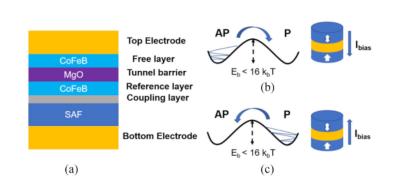Researchers from Northwestern University developed a new method of building artificial neural networks using MRAM-based stochastic computing units. The researchers say that this design could enable AI devices that are highly energy efficient.

Embedded MRAM technologies are being adopted at major foundries, which enable the use of these technologies for unconventional computing architectures that use the stochasticity of MRAM cells (rather than their nonvolatility), to perform energy-efficient computing operations. MRAM cells exhibit stochastic switching characteristics, which is a challenge for reliable memory devices. But for neural networks, this can be taken advantage of if the MTJs are appropriately designed.
In the recent research paper by the researchers, they report using six stochastic MTJs to generate the stochastic bitstreams and implement an artificial neural network (ANN) based on stochastic computing (SC) principles. The efficient realization of basic arithmetic operations may enable significantly lower energy consumption and area than ANN realizations based on conventional binary arithmetic. The SC-ANN reported by the Northwestern team was shown to achieve 95% accuracy in handwritten digit recognition using the MNIST database.

